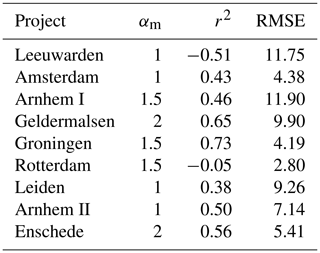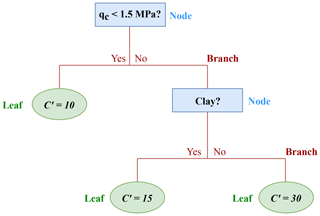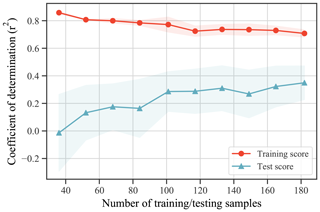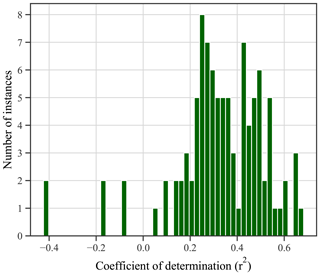the Creative Commons Attribution 4.0 License.
the Creative Commons Attribution 4.0 License.
Parameterisation of the Koppejan settlement prediction model using cone penetration testing and gradient boosting
Klaas Siderius
Mike Long
This study examines how cone penetration test (CPT) parameters, such as cone tip resistance and friction sleeve resistance, can be used to assess the compressibility of fine-grained soils across the Netherlands based on a database of 286 paired CPTs and oedometer tests from across the country. This is done with the aim of refining and simplifying the parameterisation of the Koppejan consolidation coefficients, a procedure which can yield significant error and is prone to misinterpretation. It was found that there is significant potential in using gradient boosting methods to obtain a relationship between the CPT parameters and the Koppejan parameters, with further investigation required into the noise within the dataset and the acquisition of additional high-quality samples. The use of such methods will offer a means of reducing the influence of human error or misinterpretation on the prediction of settlement and provide further confidence in the use of machine learning methods in engineering practice.
- Article
(1443 KB) - Full-text XML
- BibTeX
- EndNote
Appropriately assessing the consolidation of soil under applied loads has long been a challenge for geotechnical engineers. In the case of the Netherlands, soft clays and organic soils dominate the subsurface and the heterogeneity and high compressibility of these materials has resulted in a significant margin of error being associated with settlement calculations, in the range of ±30 % for Dutch practice (CROW, 2004). This is exacerbated by the effect of human subjectivity on the parameterisation of variables associated with settlement prediction models, a process which is highly dependent on the experience and interpretation of the engineer. Furthermore, given the sporadic and random nature of soil sampling and the sample disturbance that may also result, there is also a need to correlate these variables to continuous, in situ tests in order to obtain a more representative parameter for a soil layer. The cone penetration test (CPT) is an example of such a test and involves penetrating the ground with an instrumented steel cone and rod, measuring the cone tip resistance qc and friction sleeve resistance fs as it penetrates through the ground. It is used almost ubiquitously throughout the Netherlands and many other countries worldwide due to the many correlations its parameters have with basic soil properties along with its ability to delineate soil stratigraphy to a high resolution.
Of the settlement prediction models in the Netherlands, the Koppejan model (Koppejan, 1948) is the most prevalent, largely due to its simplicity and cost effectiveness in comparison to the more advanced models such as the a, b, c isotache model (Den Haan, 1992, 1994) or the NEN-Bjerrum model (Bjerrum, 1967). The model has also been extensively implemented in Dutch geotechnical practice and thus, many Dutch engineers have a high competence with the model. The model is based on a combination of the logarithmic compression law proposed by Terzaghi (1925) and the creep law proposed by Buisman (1936). The Koppejan parameters can be obtained directly from incremental loading oedometer tests, a procedure which assesses the one-dimensional consolidation of a small soil specimen through the application of increasing vertical loads over time on top of the specimen.
Hence, this study aims to explore the relationship between the CPT and the Koppejan compressibility parameters using both simple linear regression and machine learning, based on a database of fine-grained clay soils obtained from sites across the Netherlands.
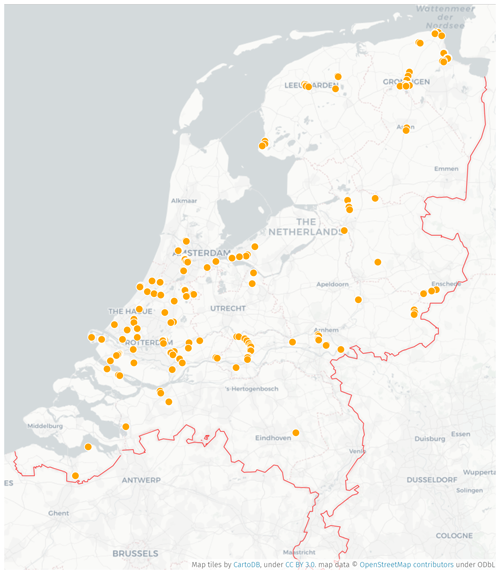
Figure 1Borehole–CPT pairings across the Netherlands (©OpenStreetMap contributors YEAR. Distributed under a Creative Commons BY-SA License, see https://www.openstreetmap.org/copyright, last access: 29 August 2019).
2.1 Geology of the Netherlands
The Netherlands is situated in a delta formed by the Rhine, Maas and Schelde rivers with much of the country being flat and altered anthropogenically, evident from its canalised streams, polders and dikes protecting the coastline and inland regions. Most of the country is dominated by Quartenary deposits, with the western half of the country immediately underlain by a very soft Holocene layer and the east by a firm sandy Pleistocene layer (Maljers et al., 2015). In the context of engineering applications, the western Holocene layer is particularly troublesome due to its high compressibility, with structures generally requiring long piles extending down towards the Pleistocene layer below (Houkes, 2016).
2.2 Data description
The data originates primarily from road and rail projects executed by Fugro throughout the Netherlands between 2008 and 2018 (see Fig. 1). For each location, sampling boreholes were automatically paired with CPT locations less than 25 m away, with the closest CPT location chosen where applicable. Given the size of the dataset, an individual geological assessment of each site was deemed infeasible and hence, a Python algorithm was developed for the oedometer–CPT test pairing process (Duffy, 2019).
In total, 286 oedometer–CPT pairs were used for the analysis, with the Koppejan's general constant of compressibility at stresses greater than the preconsolidation pressure C, the CPT cone resistance qc and the friction sleeve resistance fs brought forward for further analysis.
A direct visual relationship between C and the CPT parameters was not evident, with simple linear and multiple linear regression models affirming the lack of correlation, an example of which is shown in Fig. 2.
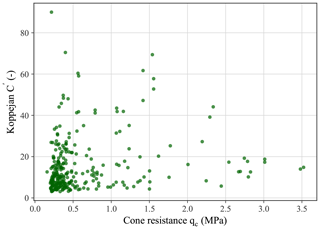
Figure 2Plot of the Koppejan C′ values against the corresponding cone resistance qc, indicating the lack of a distinct visual relationship.
Based on the correlation devised by Buisman and Huizinga (1944) shown in Eq. (1), an assessment was made of the relationship between C′, qc and the in situ vertical effective stress parameter σ0′ which describes the vertical stress transmitted between soil particles at a certain depth as a result of the weight of soil above that same depth. In obtaining σ0′, the saturated unit weight correlation for Dutch soils derived by Lengkeek et al. (2018) was used, assuming a water table of one metre throughout.
where αm is the constrained modulus cone factor.
The results of this localised assessment are shown in Table 1. Results of this study have been quantified using both the root mean square error (RMSE) and the coefficient of determination (r2), a coefficient which expresses the proportion of variance explained by the statistical model and is given in its generalised form in Eq. (2):
where SSres is the sum of squares of the residuals and SStot is the total sum of squares.
Indeed, although r2 is the square of the correlation coefficient r in the case of simple linear regression, it may also be negative in other statistical models, indicating that the mean of the data provides a better fit to the outcome than the fitted statistical model itself.
For the most part, the correlation performs relatively well. The choice of an αm coefficient can also be supported by look-up tables such as that by Mitchell and Gardner (1975) which uses the soil plasticity, water content and primary description. However, in the case of a single engineering project where CPT and laboratory data is significantly more limited, obtaining a robust αm value may prove to be relatively challenging. Hence it would be optimal if a more universal correlation for the Netherlands could be found.
In order to explore more complex non-linear patterns in the dataset, machine learning methods have been explored, including artificial neural networks, gradient boosting and XGBoost. A preliminary assessment found that gradient boosting produced the strongest results (Duffy, 2019).
4.1 Decision trees and gradient boosting
At an elementary level, decision trees are akin to a flow chart in that each “node” represents a variable, each “branch” represents a decision and each “leaf” represents an outcome. It can be used effectively for classification and regression purposes, with an example of a simple decision tree shown in Fig. 3.
In the process of creating a decision tree, the algorithm partitions the dataset into subsets of variables of similar magnitudes, ascertaining the effectiveness of potential splits as it moves through the tree. In other words, the tree assesses the improvement in model score (or reduction in error) caused by creating the split. The algorithm converges when it can no longer gain further information through the creation of more splits or when it reaches a pre-specified limit imposed on the model, known as the model's “hyperparameters”. An example of a hyperparameter may include the number of levels in the tree or the minimum number of samples required in a leaf node.
Boosting methods are an extension of the basic decision tree algorithm whereby the algorithm uses a combination of trees, with each new tree learning from the mistakes of previous trees. In this way, the model constantly aims to remove or reduce any pattern that may be preeminent in the residuals or the error. This is a core principle of the gradient boosting algorithm (Friedman, 2001).
4.2 Input parameters
In order to produce a result that is reliable and not a product of overfitting, 80 % of the data was randomly designated as training data, with the remaining 20 % being designated as unseen testing data. This split was chosen in order to retain a sufficient amount of testing data so a more robust and reliable result could be produced.
The input parameters chosen were qc, the ratio between fs and qc (also known as the friction ratio Rf) and σ0′, with Rf chosen in lieu of fs so that the possibility of any interpretability issues associated with the collinearity between qc and fs was avoided. C′ was used as the output parameter.
The gradient boosting model used as part of this study was implemented using the MLPRegressor class of the scikit-learn toolbox version 0.20.3 (Pedregosa et al., 2011), with 5-fold cross-validation used for hyperparameter tuning.
4.3 Results
The model produced an r2 score of 0.73 and 0.37 for the training and testing sets respectively, with 5-fold cross validation returning a mean score of 0.36 with standard deviation of 0.115. In the context of geotechnical engineering, this can be described as a “medium to strong correlation” as per the guidelines set out by Jakobsen (2014).
This model also returned feature importances of 0.34, 0.13 and 0.53 for qc, Rf and σ0′ respectively. These scores highlight the role each variable plays in the calculation of the C′, with qc and σ0′ being the more dominant features in determining the model output, perhaps largely due to the relative inaccuracy associated with friction sleeve measurements (Lunne et al., 1997).
Notwithstanding, Fig. 4 shows that both the training and testing curves fail to converge together at higher sample sizes. This is indicative of variance within the model, a problem that may be resolved by increasing the number of samples and thus allowing the learning curves to converge more closely, redolent of a well-fitted model.
Furthermore, as illustrated by Fig. 5, there is significant fluctuation in the r2 score as the random state of the model is changed. In other words, if different training and testing sets are taken and if the model learns slightly differently compared to its last execution, the model score changes significantly. Based on a collective assessment of one hundred different random states, the median and maximum r2 scores obtained were 0.33 and 0.68 respectively. It is surmised that this instability is indicative of the variability and noise within the dataset, consequently leading to the presence of many local minima as the algorithms undergo gradient descent along the objective function. As a result of this, the model may be particularly prone to converging within these local minima, resulting in the dispersion of results as the random state is changed.
Consequently, it is recommended that further high-quality samples are sourced for the continued development of such an algorithm in order to yield a more complete convergence of the learning curves and to investigate the effect of the change of random state on the r2 score. Further development is also required into the automated process of pairing the CPTs to the oedometer tests, with a manual assessment taken where appropriate.
A major challenge in the geotechnical engineering industry is reducing the significant amount of error associated with settlement calculations. This research has aimed to minimise the error associated with settlement prediction models by refining the parameterisation process and reducing their subjectivity by implementing a gradient boosting model, returning the appropriate Koppejan parameter based on an input of solely CPT data.
The model produced has indicated that there is some promise in using such a method in developing a universal correlation for fine-grained soils in the Netherlands and is readily extendible to other settlement prediction models upon the provision of appropriate data. However, it is apparent that further high-quality samples are required in order to produce a more robust and stable model.
Nonetheless, the results show that machine learning methods offer a means of discovering patterns in data which simpler regression methods are unable to discover and with the refinement of the CPT data, more accurate models can be developed.
The dataset generated from this study is not publicly available due to commercial restrictions, however is available from the corresponding author on reasonable request.
KS and KD were involved in the data collection and data curation. KD performed the formal analysis using statistical models and visualisation under the supervision of KS and ML. KD wrote the paper with reviews by KS and ML. KS was involved in project administration.
The authors declare that they have no conflict of interest.
This article is part of the special issue “TISOLS: the Tenth International Symposium On Land Subsidence – living with subsidence”. It is a result of the Tenth International Symposium on Land Subsidence, Delft, the Netherlands, 17–21 May 2021.
The authors are extremely grateful for the support of colleagues at Fugro and University College Dublin. Special thanks go to Thijs Lukkezen of Fugro for his advice on the machine learning segment of the research, along with the supervisory committee at University College Dublin.
This research has been kindly supported by Fugro and forms part of the Master of Engineering programme at University College Dublin.
Bjerrum, L.: Engineering geology of Norwegian normally-consolidated marine clays as related to settlements of buildings, Géotechnique, 17, 83–118, https://doi.org/10.1680/geot.1967.17.2.83, 1967.
Buisman, A. S.: Results of long duration settlement tests, in: Proceedings of the 1st International Conference on Soil Mechanics and Foundation Engineering, Cambridge, Massachusetts, 22–26 June 1936, 103–107, 1936.
Buisman, A. S. K. and Huizinga, T. K.: Grondmechanica, Leerboek der Toegepaste Mechanica: Deel IV, Waltman, Delft, the Netherlands, 281 pp., 1944 (in Dutch).
CROW: Betrouwbaarheid van zettingsprognoses, Publication 204, CROW, Ede, the Netherlands, 116 pp., 2004 (in Dutch).
Den Haan, E. J.: Denkraam voor samendrukking van verknede en natuurlijke klei: Nieuw a-b-c vereenvoudigt berekening zetting, Land en Water, 32, 25–29, 1992 (in Dutch).
Den Haan, E. J.: Vertical compression of soils, Ph.D. thesis, TU Delft, the Netherlands, 97 pp., 1994.
Duffy, K.: Assessment of a soil compressibility index using cone penetration testing and machine learning tools, M. Eng. thesis, University College Dublin, Ireland, 134 pp., 2019.
Friedman, J. H.: Greedy function approximation: a gradient boosting machine, Ann. Statist., 29, 1189–1232, https://doi.org/10.1214/aos/1013203451, 2001.
Houkes, C. B.: Review and validation of settlement prediction methods for organic soft soils, on the basis of three case studies from the Netherlands, M.Sc. thesis, TU Delft, the Netherlands, 181 pp., 2016.
Jakobsen, P. D.: Estimation of soft ground tool life in TBM tunnelling, Ph.D. thesis, NTNU, Trondheim, Norway, 253 pp., 2014.
Koppejan, A. W.: A formula combining the Terzaghi load-compression relationship and the Buisman secular time effect, Proceedings of the 2nd International Conference on Soil Mechanics and Foundation Engineering, Rotterdam, the Netherlands, 21–30 June 1948, 32–37, 1948.
Lengkeek, H. J., de Greef, J., and Joosten, S.: CPT based unit weight estimation extended to soft organic soils and peat, Proceedings of the 4th International Symposium on Cone Penetration Testing (CPT'18), Delft, the Netherlands, 21–22 June 2018, 389–394, 2018.
Lunne, T., Robertson, P. K., and Powell, J. J. M.: Cone Penetration Testing in Geotechnical Practice, 1st Edn., CRC Press, London, UK, 352 pp., 1997.
Maljers, D., Stafleu, J., van der Meulen, M. J., and Dambrink, R. M.: Advances in constructing regional geological voxel models, illustrated by their application in aggregate resource assessments, Neth. J. Geosci., 94, 257–270, https://doi.org/10.1017/njg.2014.46, 2015.
Mitchell, J. K. and Gardner, W. S.: In situ measurement of volume change characteristics, Geotechnical Speciality Conference on In Situ Measurement of Soil Properties, Raleigh, USA, 1–4 June 1975, 279–345, 1975.
Pedregosa, F., Varoquaux, G., Gramfort, A., Michel, V., Bertrand, T., Grisel, O., Blondel, M., Prettenhofer, P., Weiss, R., Dubourg, V., Vanderplas, J., Passos, A., Cournapeau, D., Brucher, M., Perrot, M., and Duchesnay, É.: Scikit-learn machine learning in Python, J. Mach. Learn. Res., 12, 2825–2830, 2011.
Terzaghi, K.: Erdbaumechanik auf bodenphysikalischer grundlage, 1st ed., Franz Deuticke, Leipzig und Wien, Germany, 399 pp., 1925 (in German).






